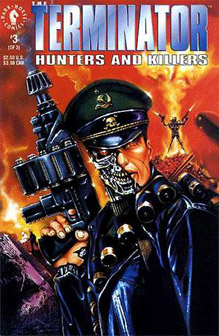After three series set in 1984, Dark Horse takes a break from that saga and delivers its first in-depth portrayal of both the Future War and a part of the world other than Los Angeles in “Hunters and Killers” (1992). In that sense, it’s a throwback to the Now Comics.
Luckily, the quality of Toren Smith’s three-issue story is a notch above what Now did, although it’s a step down from Dark Horse’s previous work. I had trouble following the story, partly because it delves deeply into Russian and Soviet politics, so that might be my fault for not brushing up on real-world history. But also, these characters are shallower than those in Dark Horse’s 1984 saga. While there’s a hint of a tragic romance between Sergey and Larissa, it’s not well-defined.
As with the story, the art by Bill Jaaska (pencils), Dan Panosia (inks) and Joe Rosas (colors) is better than most of Now’s work but a notch below the previous Dark Horse work. It’s a bit too busy and cluttered at times.
CHARACTERS
John Connor: Not in the story, but he sends a liaison over to Russia to coordinate their attack on Mir’s headquarters with the U.S. forces’ attack on Skynet’s HQ.
Sarah Connor: Dead during this time.
Kyle Reese: Not in this story, but fighting with the U.S. resistance during this time.
Captain Sergey Pavlichenko: The Russian resistance’s team leader on this mission.
Anatoly Golytsyn: The Russian resistance’s missile tech.
Sergeant Larissa Bandera: This Russian resistance fighter suspects both Sergey and Golytsyn of being Stealth Terminators. Not knowing if people are who they seem to be calls to mind “The Thing” and the “X-Files” episode “Ice” (which came out a year after this comic series).
Captain Norman Effron: The liaison between the U.S. resistance and the Russian resistance.
TERMINATORS
Stealth Terminators: The Russian branch of Skynet, known as Mir, has developed Terminators that look, behave, weigh (their endoskeletons are ceramic) and smell (thus fooling dogs’ ability to sniff them out) not only like actual humans, but like specific humans. A Sergey Pavlichenko model of Stealth Terminator is the main villain of “Hunters and Killers.” The ability to copy a specific human is Skynet’s greatest technological achievement up to this point on the timeline (although the shapeshifting T-1000 prototype is right around the corner), and of course these units can prove crucial to specific undercover missions.
Endoskeletons: These basic models are the grunts commanded by the Stealth Terminators.
CONTINUITY
“Hunters and Killers” adds another element to the 2029 saga of the takedown of Skynet. We know from the first movie that the war turned substantially the resistance’s favor when Skynet’s “defensive grid was smashed.” This comic tells us that it was essential that the Russian resistance first destroys Mir, the Russian branch of Skynet. This is because Mir is being kept in check by the U.S. Skynet. If the U.S. Skynet is destroyed, then Mir will be free to launch nuclear missiles. So Mir must be destroyed first.
A Russian resistance, operating from a submarine and a base in Cuba, was chronicled by Now Comics. The Russian resistance in “Hunters and Killers” also uses a top-of-the-line submarine for launching missiles against Mir (and which Mir wants to apprehend to launch missiles against humanity). Beyond the superficial similarities, no link between the two Russian groups is established in this story.

Stealth Terminators, for all their upgrades, have the same physical capabilities as a T-800 when it comes down to a fight. And their basic programming is the same. As the stealth unit says in Issue 3, cribbing from the T-800 of the movies, “I have detailed files on human anatomy. I will cause you great pain until you tell me the code.”
Despite the catchy title, “Hunters and Killers” doesn’t focus on Hunter-Killer aircraft, Skynet’s most popular aerial weapon, although a couple of H-Ks do pop up in the story.
TIME TRAVEL
There is no time travel in this story.

